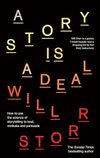A Story is a Deal: How to use the science of storytelling to lead, motivate and persuade
amazon.com
Saved by Brandon Marcus and
A Story is a Deal: How to use the science of storytelling to lead, motivate and persuade

Saved by Brandon Marcus and
To be maximally persuasive, it’s best to obey the law of simplicity. One hero, one story, one message.
What kind of people-like-us do we want to attract? Exactly what behaviours and beliefs will be incentivised, by being rewarded with status?
Our brains are programmed to connect with other brains and turn reality into a shared narrative.
Do we identify with the story it represents? Will it help us find and fuse with people-like-us? Does it offer us connection? Does it allow us to feel like better versions of ourselves? Does it offer us status? These are the questions that matter.
To achieve identification, we must understand our audience’s story-world – their heroes, villains, values, fears, hopes, obstacles and goals – and somehow reflect it back to them.
Well, what do people think of, when they think of a cult? Total cooperation. Full possession. A collection of minds so fused, and thinking as one to such a degree, that their individual identity seems lost completely.
Successful stories begin with a moment of change that incites surprise and curiosity, hijacking the brain’s need for prediction. And that’s how they should continue – with moments of unexpected change that are causally linked: one scene of change triggering the next, which triggers the next, and so on until the final scene.
We need to immerse ourselves properly in their shared reality in order that we can then reflect it back to them. What stories do they use to orient and define their identity? Who are their heroes? Their villains? What are their obstacles and goals? How do they signal connection and status?
For the German poet Friedrich von Schlegel, they have ‘the greatest quantity of thought in the smallest space’; while for the literary scholar Dr Andrew Hui, they ‘have an atomic quality – compact yet explosive’. In these respects, they recall phrases such as ‘sour